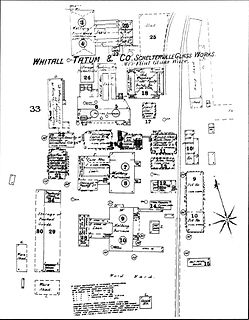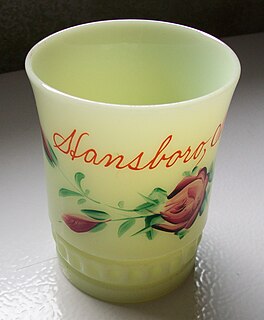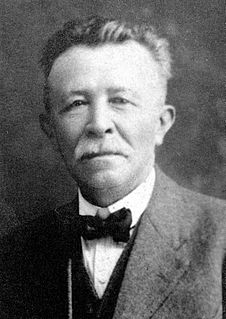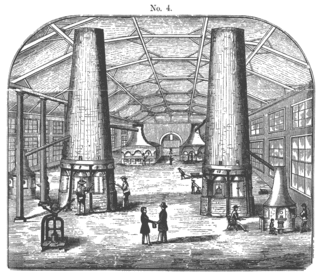
Wheaton Industries was a long-standing famous manufacturer of glassware and ceramics products in Millville, New Jersey, USA. A spin-off of the original firm adopted the name in 2006.

Blenko Glass Company, located in Milton, West Virginia, is known for its artistic hand-blown glass.

Mary Gregory (1856–1908) was an American artist known for her decoration of glass products at the Boston and Sandwich Glass Company in Cape Cod, Massachusetts. Gregory worked for Boston and Sandwich from 1880 to 1884. Gregory painted lamps and plaques of landscape scenes during her years at B&SGC.
Cambridge Glass was a manufacturer of glassware formed in 1873 in Cambridge, Ohio. The company produced a range of coloured glassware in the 1920s, initially with opaque shades, but moving on to transparent shades by the end of the decade. Unable to compete with mass-produced glassware, the company closed briefly in 1954, but was reopened in 1955. However, financial difficulties persisted, and, after several ownership changes, the factory closed for good in 1958. Imperial Glass Company purchased the Cambridge Glass molds two years later, and would use them for another three decades until that company went bankrupt in 1984.

The Whitall Tatum Company or Whitall Tatum was one of the first glass factories in the United States.

The A.H. Heisey Company was formed in Newark, Ohio, in 1895 by A.H. Heisey. The factory provided fine quality glass tableware and decorative glass figurines. Both pressed and blown glassware were made in a wide variety of patterns and colors. The company also made glass automobile headlights and Holophane Glassware lighting fixtures. The company was operated by Heisey and his sons until 1957, when the factory closed.

Sir Edward Denny Bacon, KCVO was a British philatelist who helped with the enlargement and mounting of collections possessed by rich collectors of his time and became the curator of the Royal Philatelic Collection between 1913 and 1938.

The Fenton Art Glass Company is a glass manufacturer founded in 1905 by brothers Frank L. Fenton and John W. Fenton.
The Westmoreland Glass Company was a company that produced glass in Grapeville, Pennsylvania.
The Fostoria Glass Company was a manufacturer of pressed, blown and hand-molded glassware and tableware. It began operations in Fostoria, Ohio, on December 15, 1887, on land donated by the townspeople. The new company was formed by men from West Virginia who were experienced in the glassmaking business. They started their company in northwest Ohio to take advantage of newly discovered natural gas that was an ideal fuel for glassmaking. Numerous other businesses were also started in the area, and collectively they depleted the natural gas supply. Fuel shortages caused the company to move to Moundsville, West Virginia in 1891.
Belmont Glass Company, also known as the Belmont Glass Works, was one of Ohio's early glassmaking companies. It was named after Belmont County, Ohio, where the plant was located. The firm began operations in 1866 in a riverfront village along the east side of the county, which is known as Bellaire. At that time, the community had resource advantages that made it an attractive site for glassmaking. Bellaire's location at the intersection of the Ohio River, the National Road, and two railroads meant it had an excellent transportation infrastructure. Fuel necessary for the glassmaking process was also readily available, since Belmont County was part of the eastern Ohio coal region. Bellaire also had a workforce with glassmaking expertise located less than five miles away, since glass had been produced in Wheeling, West Virginia, since the 1820s.

Henry Crimmel was an American glassmaker who became well known in Ohio and Indiana. A German that came with his family to America at the age of eight years, the American Civil War veteran started at the lowest level in glass making, and learned every aspect of the business. A skilled glassblower known for his glassmaking expertise and the recipient of two patents, he also worked in management in at least three glass factories – and was one of the co-founders of the Novelty Glass Company and the reorganized version of Sneath Glass Company. He retired with over 50 years in the industry.

The Imperial Glass Company is located in Bellaire, Ohio with a factory located on 29th Street and the offices located on Belmont Street. The factory was razed in 1995 to make room for commercial development and the Belmont Street location was transformed into a museum known as the National Imperial Glass Museum. The building was placed on the National Register on 1983-09-08.
Nicholas J. Lutz was a French glassmaker who received his training at the Cristalleries de St. Louis, and later emigrated to the United States where he settled in White Mills in Pennsylvania, later working at the Boston and Sandwich Glass Company.
Duncan & Miller Glass Company was a well-known glass manufacturing company in Washington, Pennsylvania. Items that were produced by the company are known as "Duncan glass" or "Duncan Miller glass." The company was founded in 1865 by George Duncan with his two sons and son-in-law in the South Side neighborhood of Pittsburgh, Pennsylvania. By 1890, the company joined other glass companies to form the United States Glass Company, a powerful glass trust. In 1892, the factory was destroyed in a fire, and the company was relieved of its trust relationship with the US Glass Company. After the fire, the second generation of the Duncan family moved operations to Washington, Pennsylvania. In 1900, John Ernest Miller, the company's long-time designer, became a full shareholder along with members of the Duncan family. By 1955, economic pressures from machine-produced glass forced the company to sell off its assets to the US Glass Company, who continued to produce Duncan-style glass until 1980.
Early American molded glass refers to functional and decorative objects, such as bottles and dishware, that were manufactured in the United States in the 19th century. The objects were produced by blowing molten glass into a mold, thereby causing the glass to assume the shape and pattern design of the mold. Common blown molded tableware items bearing designs include salt dishes, sugar bowls, creamers, celery stands, decanters, and drinking glasses. Household items, other than dishware, made using the three-mold method include inkwells, oil lamps, birdcage fountains, hats, medicine and perfume bottles, and witch balls. Whiskey flasks bearing unique designs were made in two part molds. Undecorated bottles used as containers for a variety of liquids were blown into square molds to give them corners so they could be packed into compartments of wooden cases.

Deming Jarves (1790–1869) was a 19th-century American glass manufacturer in Massachusetts. He co-founded the New England Glass Company and founded the Boston & Sandwich Glass Company, renowned for its pressed glass, and the Mount Washington Glass Company.
Novelty Glass Company of Fostoria was one of over 70 glass manufacturing companies that operated in northwest Ohio during the region's brief Gas Boom in the late 19th century. The company made drinking glasses, bar goods, and novelties. Organization of the firm began late in 1890, with banker Rawson Crocker as president and veteran glass man Henry Crimmel as plant manager. Production started in February 1891. The plant was built on the site of the former Buttler Art Glass Company, which had been destroyed by fire in 1889.
J. H. Hobbs, Brockunier and Company was one of the largest and best known manufacturers of glass in the United States in the 19th century. Its products were distributed world-wide. The company is responsible for one of the greatest innovations in American glassmaking—an improved formula for lime glass that enabled American glass makers to produce high-quality glass at a lower cost. The firm also developed many of the talented glassmakers that started glass factories in Ohio and Indiana.
Indiana Glass Company manufactured pressed, blown and hand-molded glassware and tableware for almost 100 years. Predecessors to the company began operations in Dunkirk, Indiana, in 1896 and 1904, when East Central Indiana experienced the Indiana gas boom. The start date for the company is considered 1907, when a group of investors led by Frank W. Merry formed a company to buy the Dunkirk glass plant that belonged to the bankrupt National Glass Company. National Glass was a trust for glass tableware that originally owned 19 glass factories including the plant in Dunkirk. National Glass went bankrupt in 1907, and its assets were sold in late 1908.











